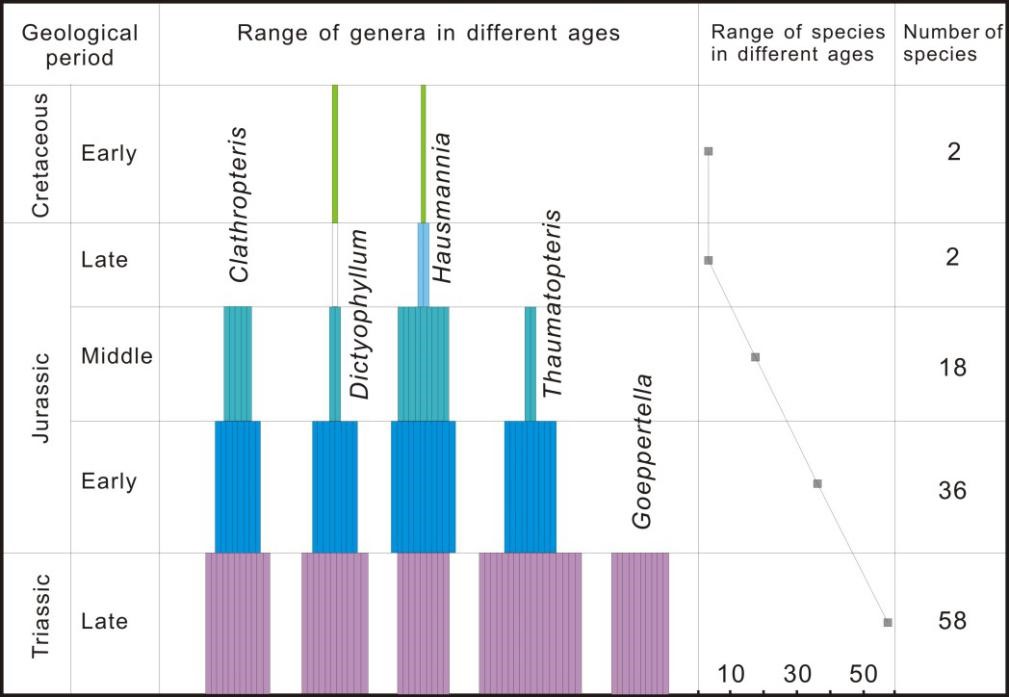The extant family Dipteridaceae includes 8 species of 1 genus (Dipteris), which is restricted to tropical and subtropical Indo-Malaysian regions, including northeastern India, and southern China. The fossil record of this family has been widely reported from the Mesozoic, and is regarded as the indicators for global warming and phytogeography. Although many studies have been focused on the systematic relationship of fossil Dipteridaceae ferns, the reproductive anatomy and in situ spores as well as diversity and distribution pattern of these fossils are relatively poor known.
Prof. WANG Yongdong from Nanjing Institute of Geology and Palaeontology, Chinese Academy of Sciences and his team members have recently investigated the fertile structures including in situ spores of a Late Triassic dipterid fern, Clathropteris obovata Oishi from Guangyuan of Sichuan Province, China. The well-preserved compression specimens show round to oval and exindusiate sori, vertical to oblique annuli in sporangia, and in situ trilete spores with verrucate and baculate sculptures, which are comparable to dispersed spore genera of Converrucosisporites and Conbaculatisporites. Comparisons of relevant fossil taxa suggest that specimens of C. obovata from Triassic of China provide for the first time in Asia the detailed fertile structures with in situ spore characters of dipterid fossil Clathropteris. Unlike living Dipteris, the fossil evidence shows a high diversity and morphological variation of in situ spores within the family Dipteridaceae in the Mesozoic, thus showing insights for the evolutionary links between Dipteridaceae and other related fern clade. This result has been published in Journal of Plant Research.
In addition, Prof. WANG et al. investigated the fossil record, diversity variation adn tampo-spatial distribution pattern of the Mesozoic Dipteridaceae ferns in China. They demonstrated that so far, about 74 species of 6 genera have been reported. Geographically, they are distributed both in Southern and Northern Floristic Provinces, and are particularly well developed in the Southern Floristic Province during the Late Triassic and the Early Jurassic interval. Fossil diversity of Dipteridaceae varies in the different episodes of the Mesozoic in China. It is shown that Dipteridaceae has undergone a diversity development process during the Mesozoic. The dipterid fossil diversity variation is supposed to be closely linked with and climate change. This result is published online in the Elsevier journal Palaeoworld.
This study was jointly supported by the State Key Basic Research Program of China, National Natural Sciences Foundation of China, the Knowledge Innovation Project of CAS, and the Team Program of Scientific Innovation and Interdisciplinary Cooperation of CAS.
Publication information:
Wang Yongdong *, Li Liqin, Guignard G, Dilcher D L., Xie Xiaoping, Tian Ning, Zhou Ning, Wang Yan, 2015. Fertile structures with in situ spores of a dipterid fern from the Triassic in southern China.Journal of Plant Research, 128: 445-457. Doi: 10.1007/s10265-015-0708-9.
Zhou Ning, Wang Yongdong*, Li Liqin, Zhang Xiaoqing, 2015. Diversity variation and tempo-spatial distribution of the Dipteridaceae ferns in the Mesozoic of China.Palaeoworld, http://dx.doi.org/10.1016/j.palwor.2015.11.008.

The fertile leaf, sori and sporangia of Clathropteris obovata from the Later Triassic of China

Sterile and fertile leaves, sporangia and in situ spores of living Dipteris conjugata

Fossil diversity variation of Dipteridaceae ferns in the Mesozoic of China
